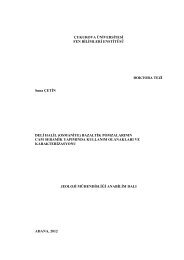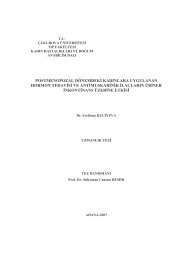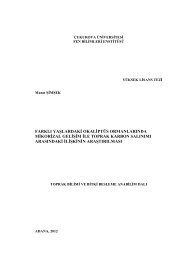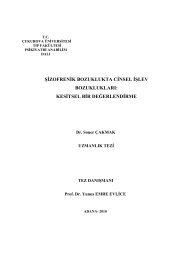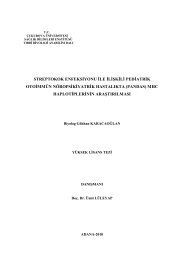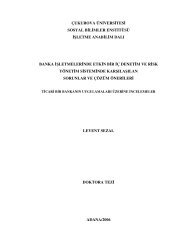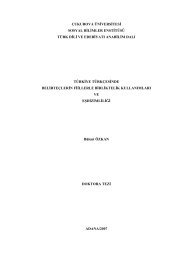ÇUKUROVA UNIVERSITY INSTITUTE OF NATURAL AND APPLIED ...
ÇUKUROVA UNIVERSITY INSTITUTE OF NATURAL AND APPLIED ...
ÇUKUROVA UNIVERSITY INSTITUTE OF NATURAL AND APPLIED ...
You also want an ePaper? Increase the reach of your titles
YUMPU automatically turns print PDFs into web optimized ePapers that Google loves.
2. POWER QUALITY Mustafa İNCİ<br />
2.2.1. Voltage Sag<br />
Voltage sags are now one of the most important power quality problems in<br />
the distribution system. A voltage sag is a momentary decrease in the RMS ac<br />
voltage (10%–90% of the nominal voltage), at the power frequency, of duration from<br />
0.5 cycles to a few seconds. Voltage sags are normally caused by short-circuit faults<br />
such as a single-line-to-ground fault in the power system or by the starting up of<br />
induction motors of large rating. Voltage sags may cause the malfunction of voltagesensitive<br />
loads in factories, buildings, and hospitals (Kangarlu et al., 2010).<br />
Voltage sags can cause tripping of contactors, motor starters, relays, restarting<br />
expense of computers and shutdown of an entire production line. The sources of<br />
voltage sags are basically faults on adjacent feeders, lighting, short circuit event, start<br />
up of heavy loads, transformer energizing and motor starting (Bollen, 2001).<br />
2.2.2. Voltage Swell<br />
Voltage swell is defined as a short duration increasing in RMS supply with<br />
increase in voltage ranging from 1.1 pu to 1.8 pu of nominal supply. The main causes<br />
for voltage swell are switching of large capacitors or removal of heavy loads<br />
(Kangarlu et al., 2010).<br />
Voltage swells might not be as common as voltage sags, however are much<br />
more harmful and disruptive to static power converters. In fact, they may severely<br />
damage or trip them, causing shutdowns of entire processes. This overall situation<br />
has become even more critical given the recent industrial trend to increase operating<br />
voltages of power converters (a practice that has pushed semiconductor devices up to<br />
their limit. A closer look to this phenomenon is, hence, required (Burgos et al.,<br />
2005).<br />
2.2.3. Voltage Fluctuations<br />
8



